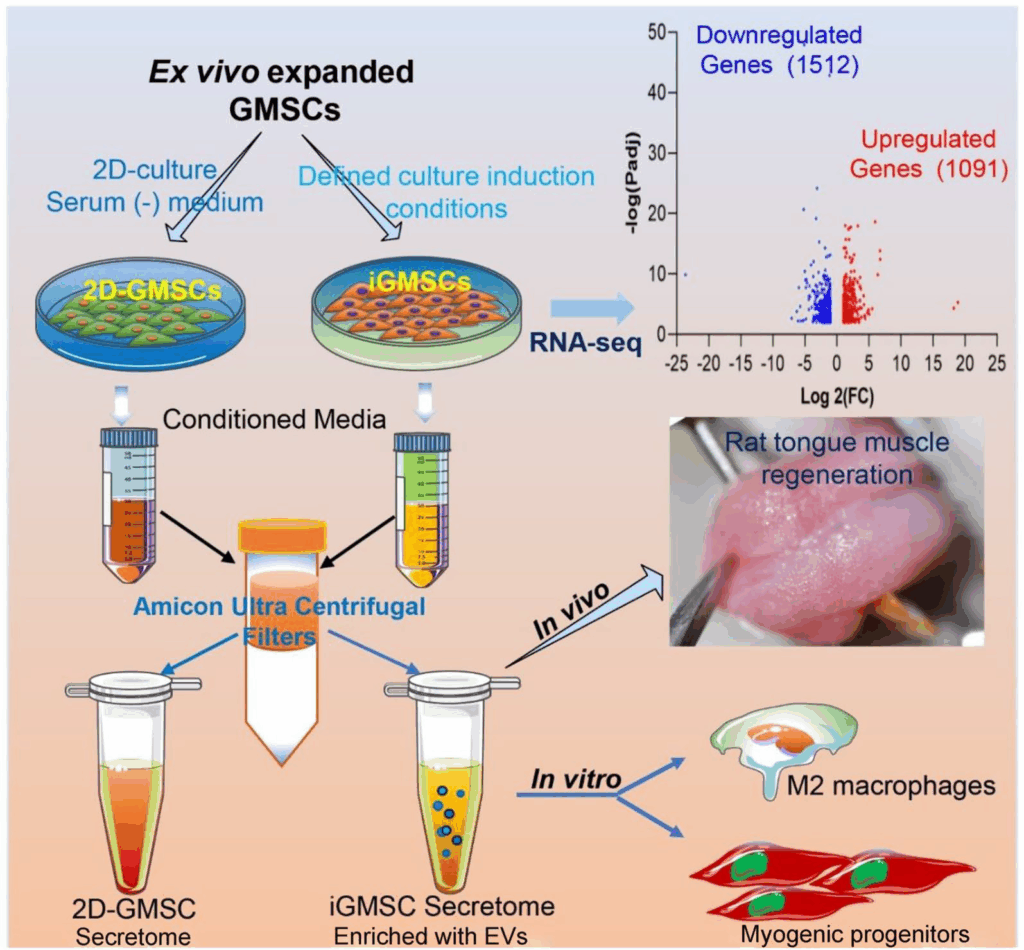Study Shows Stem Cell Secretions Show Promise in Boosting Oral Tissue Regeneration
Stem cell “secretome” has powerful wound-healing effect in preclinical test
PHILADELPHIA – The molecular secretions of stem cells taken from human gum tissue could someday be used to speed the healing and regeneration of damaged tissues in the mouth, according to a preclinical study from researchers at Penn Dental Medicine.
Stem cells with their regenerative capabilities have long been seen as potential sources of powerful new therapies. Their promise is somewhat limited by the high costs and immune rejection risks of treatments involving transfers of whole human cells. But in recent years, evidence has accumulated that the regenerative, pro-healing benefits of stem cells come largely from the molecules they secrete—their “secretome”—which in principle could be delivered much more cheaply and without immunological risks.
In the new study, published in the Journal of Nanobiotechnology, Penn Dental Medicine researchers showed with lab-dish and animal tests that the secretome obtained from human gingival (gum) stem cells—cultured with the team’s advanced method—had robust regenerative and anti-inflammatory properties and sped the healing of a significant tongue wound.

“These findings illustrate the potential of the gingival stem-cell secretome as a broadly useful therapy for enhancing the repair and regeneration of damaged oral tissues,” says Anh Le, DDS, PhD, senior author of the study.
The study’s first author was Qunzhou Zhang, PhD, who has been working with Le on strategies to enhance regeneration of the soft tissues of the face, mouth, and throat, including nerve tissue.
The secretomes of stem cells include proteins, snippets of DNA, simple organic compounds called “metabolites,” and other bioactive molecules. Some of these molecules are secreted on their own into the watery space outside the cell; others are packaged within tiny cell-like capsules called extracellular vesicles. These molecules bind to receptors and other molecules on or within surrounding cells, with effects that include the promotion of survival and growth of those cells, and the modulation of their inflammatory state.
The precise makeup of the secretome of a stem cell depends on the cell’s environment, which in the lab dish is the liquid or solid, nutrient-filled “culture medium.” Keeping stem cells alive and thriving in this lab-dish environment can be challenging, and finding the optimal ingredients for the culture medium is a focus of ongoing research. But Le and Zhang and their colleagues, in work stretching back nearly a decade, have developed a special culture medium that effectively nudges human gingival stem cells—which can be easily obtained from dental procedures—into an even more pro-regenerative state.
“These stem cells, when cultured this way, form little spheroidal structures, much as embryonic stem cells do, and secrete bioactive molecules very robustly,” Zhang says.
Le and her team have shown in their prior research that elements of the resulting secretome of these stem cells have potent regenerative effects in different preclinical models of oral tissue damage. For the new study, they obtained and concentrated what is essentially the whole secretome of these stem cells, including both soluble and vesicle-encapsulated molecules.
In lab-dish tests, they confirmed that the secretome obtained with their advanced culture method had much stronger concentrations of both soluble and vesicle-encapsulated molecules, and stronger pro-growth and anti-inflammatory properties, compared to the secretome of gingival stem cells cultured with a standard method.
In the team’s innovative rat model of tongue injury, application of the advanced secretome at the wound site led to rapid healing and regeneration of the lost tissue, without the scarring or deformity that would usually result from such tissue defect.
Le envisions using gel-based forms of such secretomes—assuming their benefits are proven in clinical trials—to enhance the healing and regeneration of a wide range of oral tissue injuries, including the gum loss of periodontitis, facial nerve damage, and the severe and potential deforming tissue loss that sometimes occurs in oral cancer surgery.
Le is the Chair and Norman Vine Endowed Professor of Oral Rehabilitation in the Department of Oral and Maxillofacial Surgery, Penn Dental Medicine
Zhang is a Research Assistant Professor of Oral and Maxillofacial Surgery, Penn Dental Medicine.
Other authors are P. He, S. Shi, Q. Xu, E. Granquist, B. A. Winkelstein, R. M. Shanti.
The work was supported by the National Institute of Dental and Craniofacial Research, the Schoenleber Foundation, and the Joseph and Josephine Rabinowitz Award for Excellence in Research.
